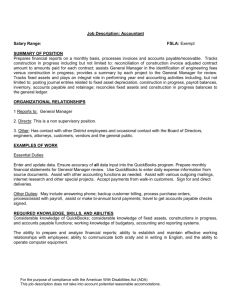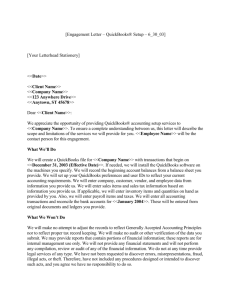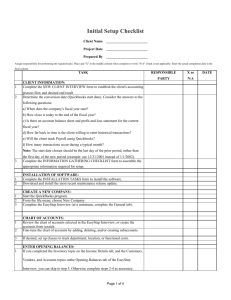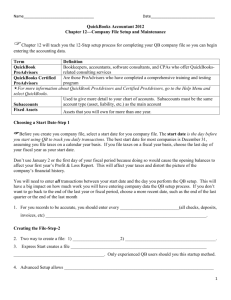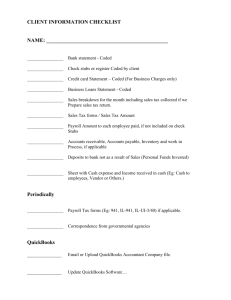Chapter 10 Company File Setup and Maintenance
advertisement
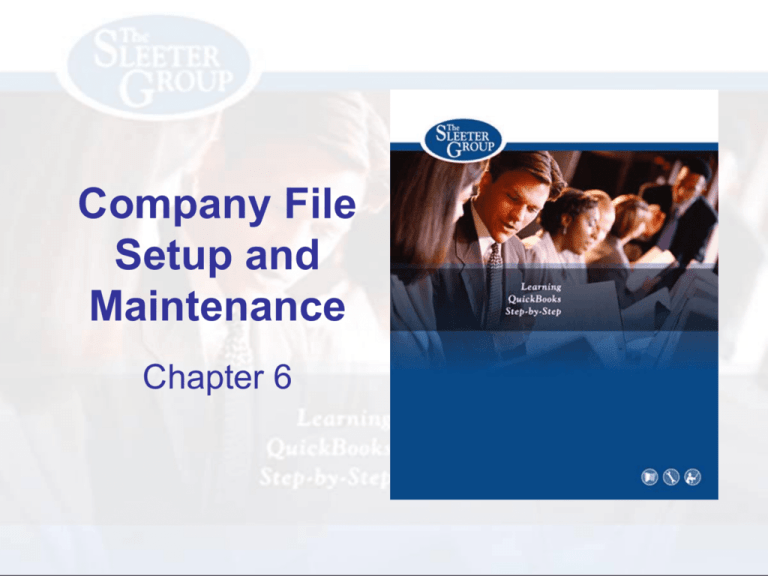
Company File Setup and Maintenance Chapter 6 Objectives • Use the EasyStep Interview • Adjust Customer and Vendor Balances after using the EasyStep Interview • Perform a Complete Company File Setup – The 12-step process • Choose a Start Date • Create the QuickBooks Company File • Set up QuickBooks Lists • Gather Your Information for Setting up Opening Balances PAGE REF # 271 CHAPTER 6: Company File Setup and Maintenance SLIDE # 2 2 Objectives (contd.) • Enter Opening Balances • Enter Year-to-Date Income and Expenses • Adjust the Opening Balance for Sales Tax Payable • Adjust Inventory for Physical Quantities on Hand • Verify your Opening Balances • Close Opening Balance Equity into Retained Earnings • Back up the File and Setting the Closing Date • Set up Users and Passwords PAGE REF # 271 CHAPTER 6: Company File Setup and Maintenance SLIDE # 3 3 PAGE REF # 272 CHAPTER 6: Company File Setup and Maintenance SLIDE # 4 4 Launching the EasyStep Interview • The EasyStep Interview feature walks you through the setup of a company file • Select the File menu and then select New Company: – The EasyStep Interview window appears – To navigate click Next or Prev – To exit the Interview and retain all changes, click Leave PAGE REF # 272 CHAPTER 6: Company File Setup and Maintenance SLIDE # 5 5 Entering Opening Balances in the EasyStep Interview • The following problems result from entering opening balances during the EasyStep Interview: – QuickBooks posts the opening balances to accounts called Uncategorized Income and Uncategorized Expenses • It is best not to enter Opening Balances for customers using the EasyStep Interview PAGE REF # 284 CHAPTER 6: Company File Setup and Maintenance SLIDE # 6 6 Adjusting Customer Opening Balances • Each customer for whom you entered an opening balance will have an Invoice that you must either edit or replace: – Edit the Item column to indicate the Items that you sold on the Invoice – Also, change the date to the original Invoice date and enter the Invoice number of the original Invoice PAGE REF # 285 CHAPTER 6: Company File Setup and Maintenance SLIDE # 7 7 Adjusting Vendor Opening Balances • Each vendor for whom you entered an opening balance will have a Bill that you must either edit or replace PAGE REF # 288 CHAPTER 6: Company File Setup and Maintenance SLIDE # 8 8 12-Step Process 1. Choose a QuickBooks start date 2. Create a new QuickBooks company file and configure your preferences 3. Set up your Chart of Accounts, company lists 4. Enter opening balances for Balance Sheet accounts (except Accounts Receivable, Accounts Payable, Inventory, Sales Tax Payable, and Retained Earnings 5. Enter outstanding transactions including Checks, Deposits, open Invoices, and unpaid Bills as of the start date 6. If you are setting up mid-year, enter your year-to-date income and expenses PAGE REF # 288 CHAPTER 6: Company File Setup and Maintenance SLIDE # 9 9 12-Step Process (contd.) 7. Adjust Sales Tax Payable 8. Adjust Inventory to match your physical counts (page 5) and set up Fixed Assets 9. Set up payroll lists and year-to-date payroll information 10. Verify that your Trial Balance report matches your accountant’s Trial Balance on your start date 11. Close the Opening Balance Equity account into Retained Earnings 12. Back up your company file and set the Closing Date and the Closing Date Password to lock the file as of your start date PAGE REF # 288 CHAPTER 6: Company File Setup and Maintenance SLIDE # 10 10 Choosing a Start Date: Step 1 • Your start date is the day before you start using QuickBooks to track your daily transactions • It is also the date for which you have complete information for your opening balances • Best start dates: – Calendar-Year Basis • December 31 – Fiscal Year basis • Last day of fiscal year – For a new company • First day of the business PAGE REF # 289 CHAPTER 6: Company File Setup and Maintenance SLIDE # 11 11 Creating the Company File: Step 2 • Launch QuickBooks • Select the File menu and then select New Company • Click Next on the first three windows of the EasyStep Interview • On the fourth window of the EasyStep Interview, click Skip Interview • Enter your company information and click Next • Select the Company type and then click Next • Enter the file name and location where you want to save your company file, click Save • It will create your company file with extension .QBW PAGE REF # 290 CHAPTER 6: Company File Setup and Maintenance SLIDE # 12 12 Setting Up the Chart of Accounts: Step 3 • To set up the Chart of Accounts, you will use the following: – – – – – – – Account Types Activating Account Numbers Adding Accounts Adding Subaccounts Removing Accounts from the Chart of Accounts Turning Off Account Numbers Reordering the Account List PAGE REF # 294 CHAPTER 6: Company File Setup and Maintenance SLIDE # 13 13 Account Types • Assets: – – – – – Bank Accounts Receivable Other Current Asset Fixed Asset Other Asset • Liabilities: – – – – Accounts Payable Credit Card Other Current Liability Long Term Liability PAGE REF # 295 • Equity • Income: – Income – Other Income • Expenses: – Expense – Other Expense – Cost of Goods Sold CHAPTER 6: Company File Setup and Maintenance SLIDE # 14 14 Activating Account Numbers • Select the Edit menu and then select Preferences • On the Preferences window, click on the Accounting icon, and select the Company Preferences tab • Then check the Use account numbers box and click OK • QuickBooks does not require account numbers PAGE REF # 295 CHAPTER 6: Company File Setup and Maintenance SLIDE # 15 15 Adding Accounts • Select the Lists menu and then select Chart of Accounts • Select the Account menu at the bottom of the Chart of Accounts window and then select New • Select account type and enter the name etc. PAGE REF # 296 CHAPTER 6: Company File Setup and Maintenance SLIDE # 16 16 Adding Subaccounts • If you want more detail in your Chart of Accounts, you can add Subaccounts • In the New Account window check the Subaccount of field and select the main account from the drop-down list PAGE REF # 298 CHAPTER 6: Company File Setup and Maintenance SLIDE # 17 17 Removing Accounts from the Chart of Accounts • Following options are available in QuickBooks to delete accounts: – Deleting Accounts - Option 1 – Deactivating Accounts - Option 2 – Merging Accounts - Option 3 • QuickBooks will not allow you to delete an account if you have used the account in an Item record or transaction • If this is the case, use either Option 2 or Option 3 to remove the account from view in the Chart of Accounts PAGE REF # 299 CHAPTER 6: Company File Setup and Maintenance SLIDE # 18 18 Deleting Accounts – Option 1 • Select the account in the Chart of Accounts list • Select the Account menu at the bottom of the Chart of Accounts window and select Delete or press CTRL+D PAGE REF # 299 CHAPTER 6: Company File Setup and Maintenance SLIDE # 19 19 Deactivating Accounts – Option 2 • If you cannot delete an account, you can deactivate it which will cause it to disappear from the Chart of Accounts and reduce the clutter: – Select the account in the Chart of Accounts. – Select the Account button and then select Make Inactive from the menu • You can still see the account in historical transactions and reports • To view all accounts, including the inactive accounts, click Show All PAGE REF # 300 CHAPTER 6: Company File Setup and Maintenance SLIDE # 20 20 Merging Accounts – Option 3 • When you merge two accounts, QuickBooks edits each transaction from the merging account so that it posts to the merged (combined) account • For example, if you merge the Entertainment account into the Meals account: – QuickBooks will edit each transaction that posts to Entertainment, making it post to Meals instead – Then QuickBooks will remove the Entertainment account from the Chart of Accounts list • Merging Cannot be Undone • Once you merge accounts together, there is no way to find out which account the old transactions used (except by reviewing from a backup file) PAGE REF # 301 CHAPTER 6: Company File Setup and Maintenance SLIDE # 21 21 Reordering the Account List • You can sort the Chart of Accounts list by the account name or number, by the (online status), or by the balance amount: – When account numbers are inactive and you click the Name header, QuickBooks sorts the account list alphabetically by account name – When account numbers are active and you click the Name header, QuickBooks sorts the list by account number – Click the other headers to sort by (Online status), Type, or Balance PAGE REF # 302 CHAPTER 6: Company File Setup and Maintenance SLIDE # 22 22 Setting Up Opening Balances: Step 4 • Gathering Your Information • Entering the Opening Balances • Understanding Opening Balance Equity PAGE REF # 305 CHAPTER 6: Company File Setup and Maintenance SLIDE # 23 23 Gathering Your Information • • • • • • • • • • Trial Balance for your start date Bank Statements (all accounts) Outstanding Checks and Deposits Open Invoices Unpaid Bills Employee List and W-4 Information Payroll Liabilities by Item Year-to-Date Payroll Detail by Employee Year-to-Date Payroll Tax Deposits Physical Inventory by Inventory Part PAGE REF # 305 CHAPTER 6: Company File Setup and Maintenance SLIDE # 24 24 Entering the Opening Balances: Step 4 (contd.) • To enter your opening balances you’ll use one of the three methods: – Method 1: Directly Editing the Account – Method 2: Adding a Transaction Directly in Registers – Method 3: Using a General Journal Entry to Record Opening Balances • The method you use will depend on three factors: – How familiar you are with accounting – Whether or not the account you’re editing has transactions – Whether you intend to use the Bank Reconciliation feature to reconcile your accounts PAGE REF # 309 CHAPTER 6: Company File Setup and Maintenance SLIDE # 25 25 Method 1: Directly Editing the Account • Use this method if you’re less familiar with accounting • Editing each account from the Chart of Accounts is the simplest way to enter opening balances for your Balance Sheet accounts: – Display the Chart of Accounts – Select the Bank account – Select the Account menu at the bottom of the list and then select Edit – Enter the amount in the Opening Balance field PAGE REF # 309 CHAPTER 6: Company File Setup and Maintenance SLIDE # 26 26 Method 2: Adding a Transaction in Registers • Use this method if the account already has transactions • you will need to enter a transaction directly in the register for the account: – Display the Chart of Accounts – Double-click the account in which you want to enter an opening balance – Enter a new transaction at the bottom of the register to record the opening balance using the start date and coding the entry to the Opening Bal Equity account – Click Record to save the entry PAGE REF # 311 CHAPTER 6: Company File Setup and Maintenance SLIDE # 27 27 Method 3: Using a General Journal Entry • Use this method if you’re familiar with using Journal Entries and if you understand debits and credits: – Select the Banking menu and then select Make General Journal Entries – Fill in the Make General Journal Entries window • You can use a General Journal Entry to record some, but not all, of your opening balances • On the top line of each General Journal Entry, use an account called Journal Entries: – Use the Bank account type when setting up this account in your Chart of Accounts – The Journal Entries account will never have a balance, so it will never show on financial statements – It will have a register where you’ll be able to look at all of your General Journal Entries PAGE REF # 312 CHAPTER 6: Company File Setup and Maintenance SLIDE # 28 28 Understanding Opening Balance Equity • This account, which is created automatically by QuickBooks is affected by each of the opening balance transactions entered into QuickBooks • As the opening balances for assets and liabilities are entered, QuickBooks automatically adds offsetting amounts in the Opening Bal Equity account • Then, after all of the opening balances are entered, Opening Bal Equity will be “closed” into Retained Earnings (or Owner’s Equity). PAGE REF # 314 CHAPTER 6: Company File Setup and Maintenance SLIDE # 29 29 Entering Open Items: Step 5 • You must enter all the outstanding transactions using the original dates: – Outstanding Checks and Deposits – Open Bills (Accounts Payable) – Open Invoices (Accounts Receivable) – Open Purchase Orders – Open Estimates and Sales Orders PAGE REF # 315 CHAPTER 6: Company File Setup and Maintenance SLIDE # 30 30 Entering Year-to-Date Income and Expenses: Step 6 • If your start date is not at the beginning of the fiscal year, use a General Journal Entry to enter your year-to-date income and expenses • The entry allows you to summarize the total income and expenses for the first few months of the year PAGE REF # 319 CHAPTER 6: Company File Setup and Maintenance SLIDE # 31 31 Adjusting Opening Balance for Sales Tax Payable: Step 7 • Open the Sales Tax Payable register • There will be entries for each of the open Invoices you entered, this is your uncollected tax • The total Sales Tax Liability is a combination of the collected tax and the uncollected tax • You will need to subtract the current balance in the account (the uncollected tax) from the amount shown on Trial Balance from your accountant to arrive at the unpaid collected tax • Then create a Sales Tax Adjustment for this difference PAGE REF # 320 CHAPTER 6: Company File Setup and Maintenance SLIDE # 32 32 Adjusting Sales Tax Payable TotalTaxDu e CollectedT ax Uncollecte dTax CollectedT ax AmountsAlr eadyCollec tedButNotP aid Uncollecte dTax TaxOnOpenI nvoices ...therefo re Adjustment Amount Collectedt ax TotalTaxDu e Uncollecte dTax PAGE REF # 320 CHAPTER 6: Company File Setup and Maintenance SLIDE # 33 33 Adjusting Inventory, Set up Fixed Assets: Step 8 • If you have inventory: – You will need to create an inventory adjustment to adjust the actual quantity and value on hand as of your start date – This is done after you enter your outstanding Bills and Invoices, so that the actual inventory counts and costs will be accurate even if some of the Bills and/or Invoices include Inventory Items • Setting up Fixed Assets: – If you have QuickBooks Pro or Premier, you can track detailed information about your company’s Fixed Assets • Setting up Loans: – If you have QuickBooks Pro or Premier, you can track detailed information about your loans PAGE REF # 321 CHAPTER 6: Company File Setup and Maintenance SLIDE # 34 34 Setup Payroll Information: Step 9 • Setting up payroll in QuickBooks is a lengthy and involved process • See QuickBooks Payroll manual in this series for more information about setting up the payroll feature PAGE REF # 322 CHAPTER 6: Company File Setup and Maintenance SLIDE # 35 35 Verifying your Trial Balance: Step 10 • Before you transfer the balance of Opening Bal Equity into Retained Earnings, make sure the account balances in QuickBooks match your accountant’s Trial Balance: – Select the Reports menu, then select Accountant & Taxes, and then select Trial Balance PAGE REF # 322 CHAPTER 6: Company File Setup and Maintenance SLIDE # 36 36 Closing Opening Balance: Step 11 • Once you have compared your Trial Balance report to your accountant’s report, use a General Journal Entry to transfer (close) the balance in Opening Bal Equity into Retained Earnings: – Select the Banking menu and then select Make Journal Entry PAGE REF # 324 CHAPTER 6: Company File Setup and Maintenance SLIDE # 37 37 Setting the Closing Date and Backing up the File: Step 12 • Set the start date as the Closing Date to Protect your Setup Balances • Backing up your data is very important part of insuring the safety of your data: – If your computer stops working – If your hard disk crashes – If you find a corruption in your file • To back up your company file: – Select the File menu and then select Backup PAGE REF # 326 CHAPTER 6: Company File Setup and Maintenance SLIDE # 38 38 Setting Up Users in the Company File • QuickBooks provides a feature for defining “users” of the file: – This feature allows the “administrator” (the owner of the file) to set privileges for each user of the file – Provides security and user tracking when several people have access to the same data file – Select the Company menu and then select Set up Users • Each user should have a password • When a user opens the company file, QuickBooks requires a user name and password • The privileges granted to that user by the administrator determine what functions of QuickBooks they can access PAGE REF # 326 CHAPTER 6: Company File Setup and Maintenance SLIDE # 39 39 Summary of Key Points • Use the EasyStep Interview • Adjust Customer and Vendor Balances after using the EasyStep Interview • Perform a Complete Company File Setup – The 12-step process • Choose a Start Date • Create the QuickBooks Company File • Set up QuickBooks Lists • Gather Your Information for Setting up Opening Balances PAGE REF # 331 CHAPTER 6: Company File Setup and Maintenance SLIDE # 40 40 Summary of Key Points (contd.) • Enter Opening Balances • Enter Year-to-Date Income and Expenses • Adjust the Opening Balance for Sales Tax Payable • Adjust Inventory for Physical Quantities on Hand • Verify your Opening Balances • Close Opening Balance Equity into Retained Earnings • Back up the File and Setting the Closing Date • Set up Users and Passwords PAGE REF # 331 CHAPTER 6: Company File Setup and Maintenance SLIDE # 41 41
